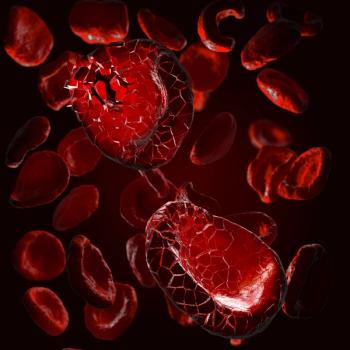
- ONCOLOGY Vol 22 No 4
- Volume 22
- Issue 4
Second-Generation TKIs in Chronic Myelogenous Leukemia
Chronic myelogeneous leukemia (CML) is a biologically unique neoplasm resulting from a mutation producing a single abnormal protein that induces unregulated proliferation of myelopoiesis. Imatinib mesylate (Gleevec) profoundly inhibits the chimeric bcr/abl tyrosine kinase, and has dramatically improved the outlook for patients with CML in chronic phase.
Chronic myelogeneous leukemia (CML) is a biologically unique neoplasm resulting from a mutation producing a single abnormal protein that induces unregulated proliferation of myelopoiesis. Imatinib mesylate (Gleevec) profoundly inhibits the chimeric bcr/abl tyrosine kinase, and has dramatically improved the outlook for patients with CML in chronic phase. The drug has become the prototype of targeted therapies in cancer and has set a perhaps unreachable bar for other putative targeted approaches, in part because the signaling abnormalities in other cancers are generally more complex and redundant, without a unique “Achilles’ heel” to attack.
Other Agents Being Studied
As summarized by Drs.Quints-Cardama and Cortes, approximately two-thirds of newly diagnosed patients remain in complete cytogenetic remission (CCyR) after 6 years of imatinib treatment, with generally modest short- or long-term side effects and an overall survival > 90%. Remarkably, a number of companies rapidly initiated drug discovery programs targeting the relatively small subgroup of patients who are either intolerant of or who do not have a sustained CCyR. Nilotinib (Tasigna) and dasatinib (Sprycel) are now approved by the US Food and Drug Administration (FDA) for these indications, and two others are in phase II/III trials.
Clearly some of this interest is aimed at replacing imatinib in first-line treatment and, indeed, three separate randomized trials comparing dasatinib, nilotinib, and bosutinib with imatinib in newly diagnosed chronic phase patients are in progress. Furthermore, a host of other companies are exploring different classes of compounds aimed at the highly resistant T315I mutation, an important contributor to treatment failure in patients with advanced CML and Philadelphia chromosome–positive acute lymphocytic leukemia (ALL), although hardly a public health hazard.
The authors summarize recent guidelines, describing certain milestones that chronic phase patients should reach if initial therapy is proceeding satisfactorily. They emphasize that these are not set in stone and likely will be modified somewhat as further data accumulate.
Key Considerations
A few other points should be stressed: To date, the most reliable predictor of long-term benefit is the achievement of a CCyR documented by bone marrow cytogenetics. After CCyR is achieved, the level of molecular response can be monitored serially by quantitative polymerase chain reaction (q-PCR) for bcr/abl using peripheral blood, although because there is an absence of standardization of both the assays and the fashion in which results are expressed (particularly in the United States), some caveats apply:
• An individual patient’s serial tests should be done in the same laboratory until better standardization is available.
• It is important to know the q-PCR result corresponding to a CyCR, since CyCR is still the proven best predictor of long-term response.
• Changes in therapy should not be based on a single result. Rather, the test should be repeated at a shorter follow-up interval if it appears the transcript levels are increasing. It is not unusual to see fluctuations in values, and close questioning of the patient about compliance with medications is important in this circumstance. If there is a question about compliance, measurement of imatinib blood levels should be considered.
If a change in treatment is contemplated, marrow cytogenetics should be done to detect possible clonal evolution, and bcr/abl mutational analysis should be performed. Such mutations can be detected in only ~50% of patients with imatinib resistance. The other mechanisms of resistance are poorly understood, although it should be noted that rates of response to nilotinib and dasatinib are similar in patients with or without detectable mutations.
The development of mutations can also be viewed as a marker of genetic instability associated with the accumulation of these other genetic alterations leading to drug resistance. Conversely, some mutations occur in only a minority of cells and can be transient, even with continuation of imatinib therapy. Hence, mutational analysis is not appropriate in the absence of signs of clinical, cytogenetic, or gross molecular worsening.
Role of Allogeneic Transplantation
There is some controversy about whether patients who have achieved CCyR with nilotinib and dasatinib should be considered for allogeneic transplantation. Certainly, for patients in accelerated or blast phases, transplantation should be implemented if feasible, because there appears to be a progressive relapse rate even in good responders.
Although the initial evaluations of the duration of response in patients in chronic phase are encouraging, the follow-up is short. At a minimum, such patients should be monitored closely with simultaneous testing for the availability of suitable histocompatible donors. Factors such as patient age and other medical problems, the quality of the donor match, and the depth of the response to the second-line TKIs influence the recommendation in individual patients.
Conclusions
The short-term results of treatment with second-generation TKIs have been very encouraging, although a significant fraction of imatinib-refractory patients either fail to respond or have disease recurrence. Because of this, patients being considered for such treatment should be directed to physicians with expertise in the management of CML, with discussions of transplantation in suitable individuals.
Financial Disclosure: Dr. Schiffer has received grant support from Novartis and Bristol-Myers Squibb. He is also a consultant and on the speakers bureau for Novartis.
Articles in this issue
over 17 years ago
SP1049C Is Granted Orphan Drug Status for Gastric Cancerover 17 years ago
Epothilones: Clinical Update and Future Directionsover 17 years ago
Emergence of the Epothilonesover 17 years ago
Evolving Role of the Epothilonesover 17 years ago
Sorting Out the Targeted-Agent Combinations for Colorectal Cancerover 17 years ago
Refractory CML: Not All Forms of Resistance Are EqualNewsletter
Stay up to date on recent advances in the multidisciplinary approach to cancer.

















































































